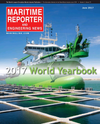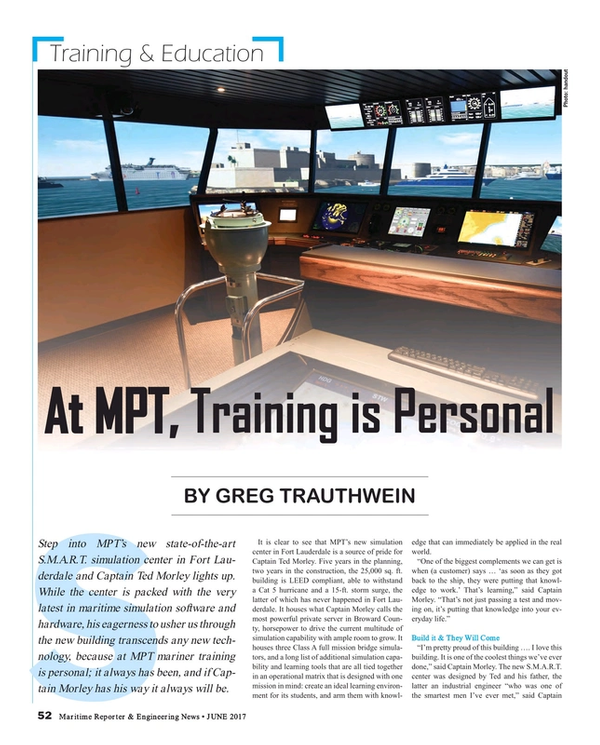
At MPT, Training is Personal
By Greg Trauthwein
Step into MPT’s new state-of-the-art S.M.A.R.T. simulation center in Fort Lauderdale and Captain Ted Morley lights up. While the center is packed with the very latest in maritime simulation software and hardware, his eagerness to usher us through the new building transcends any new technology, because at MPT mariner training is personal; it always has been, and if Captain Morley has his way it always will be.
It is clear to see that MPT’s new simulation center in Fort Lauderdale is a source of pride for Captain Ted Morley. Five years in the planning, two years in the construction, the 25,000 sq. ft. building is LEED compliant, able to withstand a Cat 5 hurricane and a 15-ft. storm surge, the latter of which has never happened in Fort Lauderdale. It houses what Captain Morley calls the most powerful private server in Broward County, horsepower to drive the current multitude of simulation capability with ample room to grow. It houses three Class A full mission bridge simulators, and a long list of additional simulation capability and learning tools that are all tied together in an operational matrix that is designed with one mission in mind: create an ideal learning environment for its students, and arm them with knowledge that can immediately be applied in the real world.
“One of the biggest complements we can get is when (a customer) says … ‘as soon as they got back to the ship, they were putting that knowledge to work.’ That’s learning,” said Captain Morley. “That’s not just passing a test and moving on, it’s putting that knowledge into your everyday life.”
Build it & They Will Come
“I’m pretty proud of this building …. I love this building. It is one of the coolest things we’ve ever done,” said Captain Morley. The new S.M.A.R.T. center was designed by Ted and his father, the latter an industrial engineer “who was one of the smartest men I’ve ever met,” said Captain Morley. “My father was great at creating things, machines, and I look at this building as one big machine.”
But the heart of any learning institution is the people, and that’s where Capt. Morley fits in. “Inserting the people in this machine and making it work. That’s my specialty.”
Through all of the high tech bells and whistles featured in the S.M.A.R.T. Center, the conversation always seems to come back to the human assets, the students. “It’s all in the details, it’s about making that person open and willing to receive that information,” said Captain Morley. “Take the chairs for example. It might seem silly to spend $500 per chair when you’re buying 300 chairs. That’s a lot of money and you could buy a house for what we spent on student chairs. But if they’re not comfortable, they’re not learning. It’s all about creating a comfortable environment: we get how education works, and we care about our students. We’re a school that is run by a mariner.”
Around every corner is another subtle touch designed to keep students focused, whether the grand rock wall seen when entering the building, the overall color scheme down to the granite in the bathrooms.
“It’s not about just trying to look nice; it’s the human element, the textured elements, the color palette, the 3D glass mosaic wall, the furnishings: are all geared toward helping the student relax,” said Captain Morley. “Simulation training is not physically taxing, but it is mentally taxing. The brain needs to ‘switch off’ when it’s out of a stressful situation, and the interior elements of the new center help the brain to do that.” In MPT’s new facility more than 60% is dedicated to simulation, with additional classrooms and student areas making up the remaining space. An additional 9,000 of existing space was remodeled with new classrooms, meeting areas, and a conference center and all four Broward County campuses received significant technology upgrades allowing for live streaming and cloud-based data sharing between them. In total the MPT campus is now 61,000 sq. ft., and MPT’s investment in this upgrade was self-funded and exceeded $6 million.
Tech Transfer
While the focus is on the student experience, the technology delivers the ‘wow’ factor. The main bridge in the new center is the largest, the flagship bridge. “This bridge is really an amazing piece of kit. That chart table back here, for example, is the only one that exists in simulation. It is one-of-one right now, and the reason it is one-of-one is because it is my creation,” said Captain Morley. “What you have here is a full navigational planning station that can be transmitted from here, electronically, onto the active ECDIS unit. So for route planning you can have someone working on the route, while the bridge team is navigating the current route. When it is sent, it is uploaded, and then the bridge team can accept it and start navigating the new route. It is a really neat training evolution.”
In early March 2017 MPT was finalizing the installation of its new Full Mission Liquid Cargo Simulator, a new capability for the center. “As STCW requires more simulation training, we looked at our offerings and decided that Liquid Cargo simulation training was needed,” said Captain Morley.
The Evolution of Simulation Training
Simulation has changed dramatically in the past five years and operators are able to utilize simulators for much more than simple regulatory training. Being able to conduct realistic vessel familiarization, port building projects, dredging impact studies, and realistic tug/ship interactions are vital as our ports get more congested and the ships get larger. Simulation is a major component of port safety, from the ship and tug operators up to the VTS controllers.
“A big contributor is processing power, which is driving the visuals. It takes someone about 15 to 20 minutes from entering the simulator to really feel that they are on a ship. If they’re in heavy weather they start walking funny. But if the visuals don’t work, nothing else does either,” said Captain Morley.
The visuals in the upgraded simulator are comprehensive, complete with planes taking off and landing from the local airport, real local landmarks, and even a ‘reflectivity’ upgrade meaning operators can see real life reflections on the water. “It simulates not only the bathymetrics of the tides, but the visuals that correspond,” said Captain Morley. “Another big change is the bathymetry and meteorological information, the ability to simulate the environment outside of the vessel. Simulating radar or ECDIS has been there for a long time, but now we are simulating how the outside world impacts the ship (much more accurately).”
“From a mariner’s perspective, it is simply amazing to see how far and fast technology is leaping. Cruise ships and yachts always had the new technology while the tankers and the cargo ships lagged behind,” said Captain Morley. “Not anymore. All of the new ships have an amazing amount of modern equipment, and just another reason why simulation centers have to step up.”
(As published in the June 2017 edition of Maritime Reporter & Engineering News)
Read At MPT, Training is Personal in Pdf, Flash or Html5 edition of June 2017 Maritime Reporter
Other stories from June 2017 issue
Content
- Melting Sea Ice: A Canary in the Coal Mine page: 12
- Improved Safety and Training, Step-by-step page: 16
- ALMACO's CEO is Bullish on Maritime page: 18
- IADC’s René Kolman: 'Primus inter pares' page: 26
- Dredging: Digging Deep for a 'WIIN' page: 32
- US Navy: Bigger is Better, but at What Cost? page: 34
- Earth, Wind & … Fire Protection page: 48
- At MPT, Training is Personal page: 52
- Simulation Training at MSRC page: 54
- Rolls-Royce & the Future Tech 'Reality' page: 56
- Viega: Maintaining the Flow page: 66


